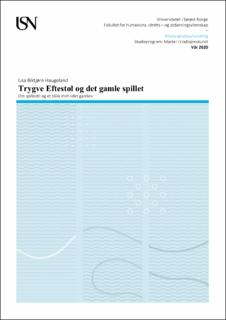| dc.description.abstract | This thesis examines the playing style of the fiddler Trygve Eftestøl (1901-1993), from Fjotland in Vest-Agder. Eftestøl is the last member of a long family line of fiddle players from Fjotland, and also the last one from a living tradition to be recorded. Eftestøl´s distinctive style shows how interesting the elderly ways of playing are when it comes to the regular fiddle. Different methods have been used to investigate this so-called "old way of playing". One of such is to find answers to what elements today`s folk musicians who know about Trygve Eftestøl and to a greater or lesser extent, have used his music are interviewed. I have also used my own practice and experience as a fiddler as a base for this discussion. Some practices put in place were; learning several tunes from archival recordings, both audio and video, transcribing parts of the material, using the Melodyne music program and looking into the spesific bowing techniques and ornamentations used by the player.
The overall aim has been to find important elements that make the style what it is, for the further practice and dissemination of this music. The elements that have proved particularly characteristic of Eftestøl´s style have been tonality, rhythm, multi-string use and ornamentation.
Another important part of this thesis is to bring up questions about "the old" in reference to wider folk music. Most of the characteristic elements of Eftestøl´s style are said to be "old" and appear to be little used by folk musicians today. Personally, I find that there is a lot of talk about when discussing what is "old", both in literature and in the living folk music environment. Such as how old it is, where it comes from, why it is little used today and why the "old" is so important to us. On the other hand, this is difficult to find clear answers to. Finding answers to such questions has therefore been an important part of this work. In connection with what has emerged as important elements in Eftestøl´s style, I have also tried to answer how old these elements are, where they come from, and why they are little used today.
The purpose of this assignment is to create awareness of and interest in Trygve Eftestøl´s music, while also aiming to build interest and further discussion into "the old" in general in folk music. | en_US |
